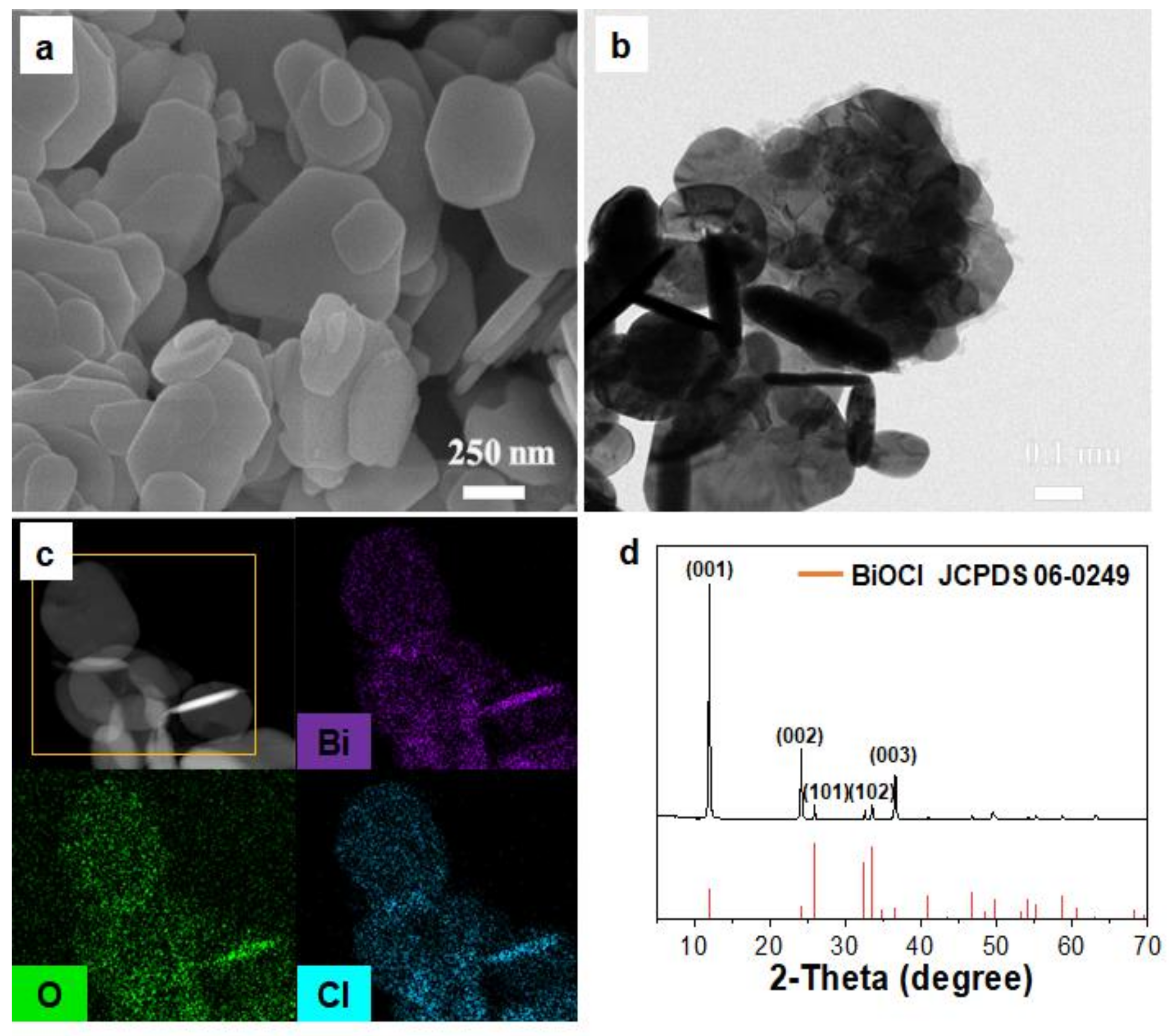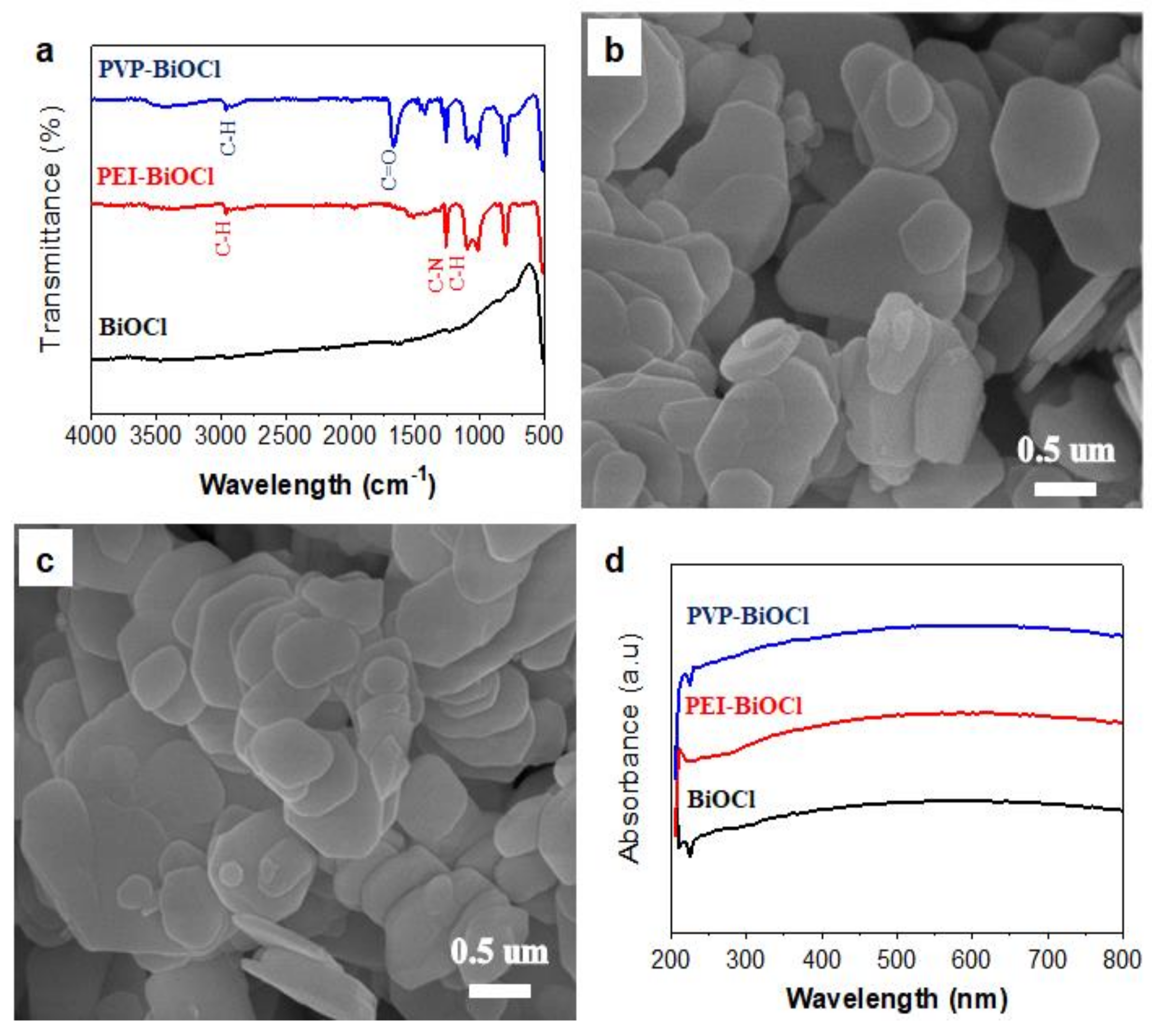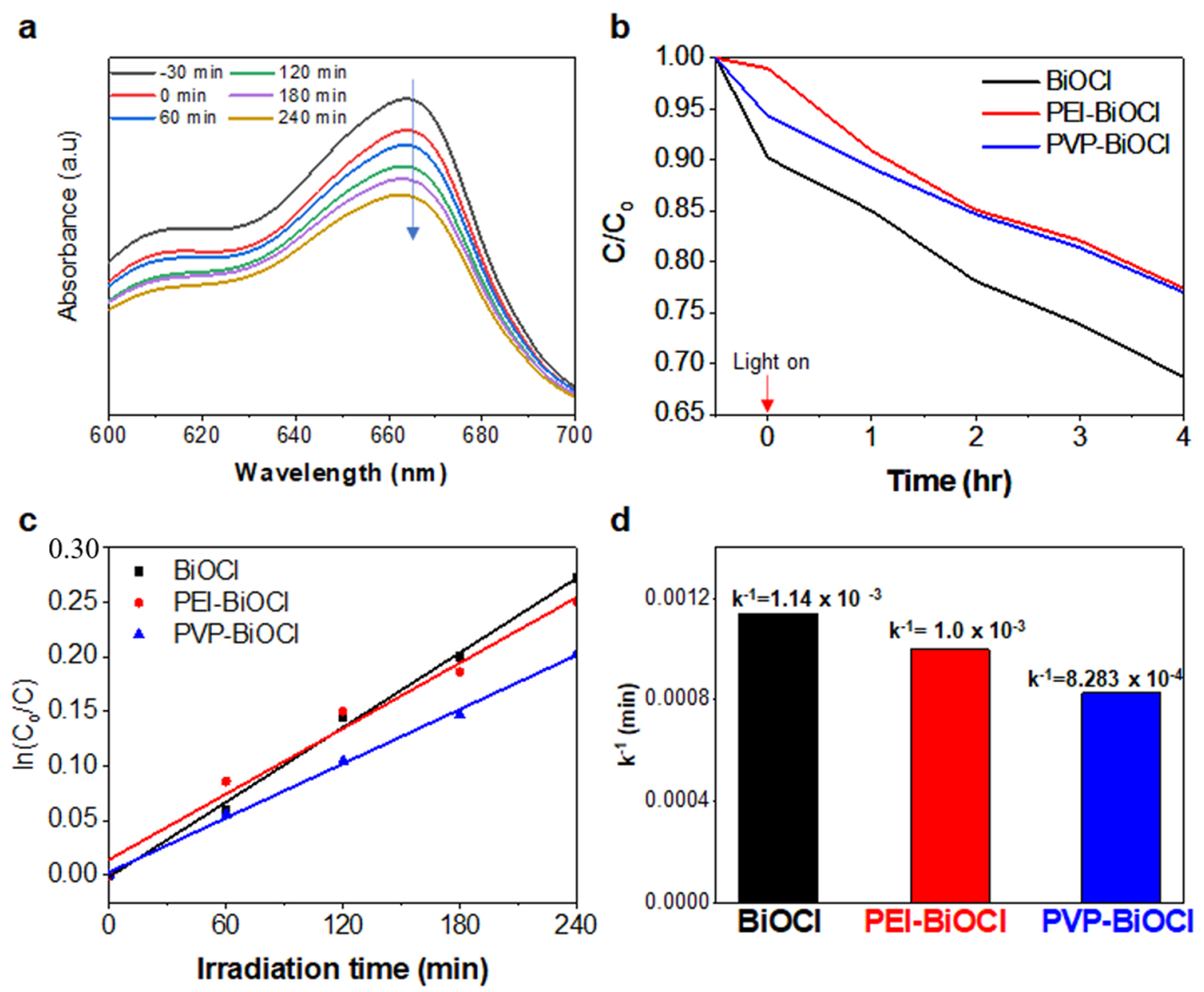Facile Aqueous-Phase Synthesis of Stabilizer-Free Photocatalytic Nanoparticles
Abstract
1. Introduction
2. Results
3. Materials and Methods
3.1. Materials
3.2. Synthesis of BiOCl Nanoplates
3.3. Attachment of Stabilizer to the Surface of BiOCl Nanoplates
3.4. Characterization
3.5. Evaluation of Photocatalytic Activity
4. Conclusions
Supplementary Materials
Author Contributions
Funding
Data Availability Statement
Conflicts of Interest
References
- Gentile, A.; Ruffino, F.; Grimaldi, M.G. Complex-morphology metal-based nanostructures: Fabrication, characterization, and applications. Nanomaterials 2016, 6, 110. [Google Scholar] [CrossRef]
- Pankhurst, Q.A.; Connolly, J.; Jones, S.K.; Dobson, J. Applications of magnetic nanoparticles in biomedicine. J. Phys. D Appl. Phys. 2003, 36, R167–R181. [Google Scholar] [CrossRef]
- Kim, E.Y.; Kumar, D.; Khanga, G.; Lim, D.K. Recent advances in gold nanoparticle-based bioengineering applications. J. Mater. Chem. B 2015, 3, 8433–8444. [Google Scholar] [CrossRef] [PubMed]
- Park, J.; Kwon, T.; Kim, J.; Jin, H.; Kim, H.Y.; Kim, B.; Joo, S.H.; Lee, K. Hollow nanoparticles as emerging electrocatalysts for renewable energy conversion reactions. Chem. Soc. Rev. 2018, 47, 8173–8202. [Google Scholar] [CrossRef]
- Wessells, C.D.; McDowell, M.T.; Peddada, S.V.; Pasta, M.; Huggins, R.A.; Cui, Y. Tunable reaction potentials in open framework nanoparticle battery electrodes for grid-scale energy storage. ACS Nano 2012, 6, 1688–1694. [Google Scholar] [CrossRef] [PubMed]
- Polshettiwar, V.; Luque, R.; Fihri, A.; Zhu, H.; Bouhrara, M.; Basset, J.-M. Magnetically recoverable nanocatalysts. Chem. Rev. 2011, 111, 3036–3075. [Google Scholar] [CrossRef] [PubMed]
- Yamamoto, K.; Imaoka, T.; Chun, W.-J.; Enoki, O.; Katoh, H.; Takenaga, M.; Sonoi, A. Size-specific catalytic activity of platinum clusters enhances oxygen reduction reactions. Nat. Chem. 2009, 1, 397–402. [Google Scholar]
- Li, Y.; Huang, Y. Morphology-Controlled Synthesis of Platinum Nanocrystals with Specific Peptides. Adv. Mater. 2010, 22, 1921–1925. [Google Scholar] [CrossRef]
- San, B.H.; Kim, S.; Moh, S.H.; Lee, H.; Jung, D.Y.; Kim, K.K. Platinum nanoparticles encapsulated by aminopeptidase: A multifunctional bioinorganic nanohybrid catalyst. Angew. Chem. Int. Ed. 2011, 50, 11924–11929. [Google Scholar] [CrossRef]
- Tanaka, S.I.; Miyazaki, J.; Tiwari, D.K.; Jin, T.; Inouye, Y. Fluorescent platinum nanoclusters: Synthesis, purification, characterization, and application to bioimaging. Angew. Chem. Int. Ed. 2011, 50, 451–455. [Google Scholar] [CrossRef]
- Stowell, C.A.; Korgel, B.A. Iridium nanocrystal synthesis and surface coating-dependent catalytic activity. Nano Lett. 2005, 5, 1203–1207. [Google Scholar] [CrossRef] [PubMed]
- Borodko, Y.; Habas, S.E.; Koebel, M.; Yang, P.; Frei, H.; Somorjai, G.A. Charge-transfer interaction of poly(vinylpyrrolidone) with platinum and rhodium nanoparticles. J. Phys. Chem. B 2006, 110, 23052–23059. [Google Scholar] [CrossRef] [PubMed]
- Lee, H.; Habas, S.E.; Kweskin, S.; Butcher, D.; Somorjai, G.A.; Yang, P. Morphological control of catalytically active platinum nanocrystals. Angew. Chem. Int. Ed. 2006, 45, 7824–7828. [Google Scholar] [CrossRef] [PubMed]
- Zhang, P.; Zhang, J.; Gong, J. Tantalum-based semiconductors for solar water splitting. Chem. Soc. Rev. 2014, 43, 4395–4422. [Google Scholar] [CrossRef] [PubMed]
- Hisatomi, T.; Kubota, J.; Domen, K. Recent advances in semiconductors for photocatalytic and photoelectrochemical water splitting. Chem. Soc. Rev. 2014, 43, 7520–7535. [Google Scholar] [CrossRef] [PubMed]
- Lee, G.J.; Zheng, Y.-C.; Wu, J.J. Fabrication of hierarchical bismuth oxyhalides (BiOX, X = Cl, Br, I) materials and application of photocatalytic hydrogen production from water splitting. Catal. Today 2018, 307, 197–204. [Google Scholar] [CrossRef]
- Zhang, X.; Li, B.; Wang, J.; Yuan, Y.; Zhang, Q.; Gao, Z.; Liu, L.M.; Chen, L. The stabilities and electronic structures of single-layer bismuth oxyhalides for photocatalytic water splitting. Phys. Chem. Chem. Phys. 2014, 16, 25854–25861. [Google Scholar] [CrossRef]
- Gao, X.; Zhang, X.; Wang, Y.; Peng, S.; Yue, B.; Fan, C. Photocatalytic degradation of carbamazepine using hierarchical BiOCl microspheres: Some key operating parameters, degradation intermediates and reaction pathway. Chem. Eng. J. 2015, 273, 156–165. [Google Scholar] [CrossRef]
- Ye, L.; Jin, X.; Liu, C.; Ding, C.; Xie, H.; Chu, K.H.; Wong, P.K. Oxygen vacancies induced exciton dissociation of flexible BiOCl nanosheets for effective photocatalytic CO2 conversion. Appl. Catal. B. 2016, 187, 281–290. [Google Scholar] [CrossRef]
- Li, H.; Shang, J.; Shi, J.; Zhao, K.; Zhang, L. Facet-dependent solar ammonia synthesis of BiOCl nanosheets via a proton-assisted electron transfer pathway. Nanoscale 2016, 8, 1986–1993. [Google Scholar] [CrossRef]
- Di, J.; Xia, J.; Li, H.; Guo, S.; Dai, S. Bismuth oxyhalide layered materials for energy and environmental applications. Nano Energy 2017, 41, 172–192. [Google Scholar] [CrossRef]
- Bai, S.; Li, X.; Kong, Q.; Long, R.; Wang, C.; Jiang, J.; Xiong, Y. Toward enhanced photocatalytic oxygen evolution: Synergetic utilization of plasmonic effect and Schottky junction via interfacing facet selection. Adv. Mater. 2015, 27, 3444–3452. [Google Scholar] [CrossRef]
- Cao, S.; Guo, C.; Lv, Y.; Guo, Y.; Liu, Q. A novel BiOCl film with flowerlike hierarchical structures and its optical properties. Nanotechnology 2009, 20, 275702. [Google Scholar] [CrossRef]
- Sharma, K.; Dutta, V.; Sharma, S.; Raizada, P.; Hosseini-Bandegharaei, A.; Thakur, P.; Singh, P. Recent advances in enhanced photocatalytic activity of bismuth oxyhalides for efficient photocatalysis of organic pollutants in water: A review. J. Ind. Eng. Chem. 2019, 78, 1–20. [Google Scholar] [CrossRef]
- Zhang, K.L.; Liu, C.M.; Huang, F.Q.; Zheng, C.; Wang, W.D. Study of the electronic structure and photocatalytic activity of the BiOCl photocatalyst. Appl. Catal. B Environ. 2006, 68, 125–129. [Google Scholar] [CrossRef]
- Ye, P.; Xie, J.; He, Y.; Zhang, L.; Wu, T.; Wu, Y. Hydrolytic synthesis of flower like BiOCl and its photocatalytic performance under visible light. Mater. Lett. 2013, 108, 168–171. [Google Scholar] [CrossRef]
- Chen, L.; Yin, S.F.; Huang, R.; Zhou, Y.; Luo, S.L.; Au, C.T. Facile synthesis of BiOCl nano-flowers of narrow band gap and their visible-light-induced photocatalytic property. Catal. Commun. 2012, 23, 54–57. [Google Scholar] [CrossRef]
- Armelao, L.; Bottaro, G.; Maccatoc, C.; Tondello, E. Bismuth oxychloride nanoflakes: Interplay between composition-structure and optical properties. Dalton Trans. 2012, 41, 5480. [Google Scholar] [CrossRef]
- Wu, Y.; Yuan, B.; Li, M.; Zhang, W.H.; Liu, Y.; Li, C. Well-defined BiOCl colloidal ultrathin nanosheets: Synthesis, characterization, and application in photocatalytic aerobic oxidation of secondary amines. Chem. Sci. 2015, 6, 1873. [Google Scholar] [CrossRef]
- Li, J.; Yu, Y.; Zhang, L. Bismuth oxyhalide nanomaterials: Layered structures meet photocatalysis. Nanoscale 2014, 6, 8473–8488. [Google Scholar] [CrossRef]
- Shi, W.; Sahoo, Y.; Zeng, H.; Ding, Y.; Swihart, M.; Prasad, P. Anisotropic growth of PbSe nanocrystals on Au–Fe3O4 hybrid nanoparticles. Adv. Mater. 2006, 18, 1889–1894. [Google Scholar] [CrossRef]
- Hoefelmeyer, J.D.; Niesz, K.; Somorjai, G.A.; Tilley, T.D. Radial Anisotropic Growth of Rhodium Nanoparticles. Nano Lett. 2005, 5, 435–438. [Google Scholar] [CrossRef] [PubMed]
- Zhang, X.; Wang, L.W.; Wang, C.Y.; Wang, W.K.; Chen, Y.L.; Huang, Y.X.; Li, W.W.; Feng, Y.J.; Yu, H.Q. Synthesis of BiOClxBr1−x nanoplate solid solutions as a robust photocatalyst with tunable band structure. Chem. Eur. J. 2015, 21, 11872–11877. [Google Scholar] [CrossRef] [PubMed]
- Yang, J.; Liang, Y.; Li, K.; Zhu, Y.; Liu, S.; Xu, R.; Zhou, W. Design of 3D flowerlike BiOClxBr1-x nanostructure with high surface area for visible light photocatalytic activitie. J. Alloys Compd. 2017, 725, 1144–1157. [Google Scholar] [CrossRef]
- Lim, G.H.; Yu, T.; Koh, T.; Lee, J.H.; Jeong, U.; Lim, B. Reduction by water for eco-friendly, capping agent-free synthesis of ultrasmall platinum nanocrystals. Chem. Phys. Lett. 2014, 595, 77–82. [Google Scholar] [CrossRef]



Publisher’s Note: MDPI stays neutral with regard to jurisdictional claims in published maps and institutional affiliations. |
© 2021 by the authors. Licensee MDPI, Basel, Switzerland. This article is an open access article distributed under the terms and conditions of the Creative Commons Attribution (CC BY) license (http://creativecommons.org/licenses/by/4.0/).
Share and Cite
Lee, H.; Kim, S.-S.; Bhang, S.H.; Yu, T. Facile Aqueous-Phase Synthesis of Stabilizer-Free Photocatalytic Nanoparticles. Catalysts 2021, 11, 111. https://doi.org/10.3390/catal11010111
Lee H, Kim S-S, Bhang SH, Yu T. Facile Aqueous-Phase Synthesis of Stabilizer-Free Photocatalytic Nanoparticles. Catalysts. 2021; 11(1):111. https://doi.org/10.3390/catal11010111
Chicago/Turabian StyleLee, Hyein, Sung-Soo Kim, Suk Ho Bhang, and Taekyung Yu. 2021. "Facile Aqueous-Phase Synthesis of Stabilizer-Free Photocatalytic Nanoparticles" Catalysts 11, no. 1: 111. https://doi.org/10.3390/catal11010111
APA StyleLee, H., Kim, S.-S., Bhang, S. H., & Yu, T. (2021). Facile Aqueous-Phase Synthesis of Stabilizer-Free Photocatalytic Nanoparticles. Catalysts, 11(1), 111. https://doi.org/10.3390/catal11010111






